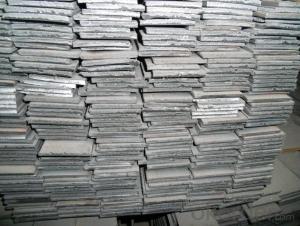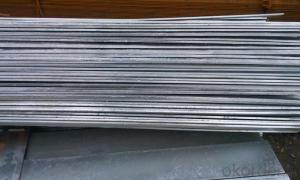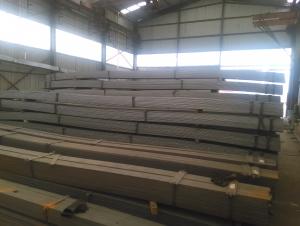flat bar
- Loading Port:
- China Main Port
- Payment Terms:
- TT OR LC
- Min Order Qty:
- -
- Supply Capability:
- -
OKorder Service Pledge
OKorder Financial Service
You Might Also Like
Product Description:
Specification of Mild Steel Flat Bar
Commodity: Mild Steel Flat Bar
Standard: GB;JIS
Material: Q195-235;SS400
Brand name: FLATSPACE
Origin place: China
Thickness: 3mm-30mm
Width:20mm-200mm
Length: Max 12m
Certification: SGS/BV
Chemical composition of Q235
Alloy No | Grade | Element(%) | ||||
C | Mn | S | P | Si | ||
Q235 | B | 0.12—0.20 | 0.3—0.7 | ≤0.045 | ≤0.045 | ≤0.3 |
Physical properties of Q235
Alloy No | Grade | Yielding strength point(Mpa) | Tensile strength (Mpa) | Elongation after fracture(%) | ||||||
Thickness (mm) | Thickness (mm) | |||||||||
≤16 | >16--40 | >40--60 | >60--100 | ≤16 | >16--40 | >40--60 | >60--100 | |||
≥ | ≥ | |||||||||
Q235 | B | 235 | 225 | 215 | 205 | 375--500 | 26 | 25 | 24 | 23 |
Usage/Applications of Mild Steel Flat Bar
Widely used for construction, Machinery manufacturing, Iron tower steel structure, Shipbuilding; Steel grating, Staircase, Bridge, Viaduct, Railway spare parts, Boilers making etc.
Packaging & Delivery of Mild Steel Flat Bar
Packaging Details: The Mild Steel Flat Bars are packed in bundles and loaded in 20 feet/40 feet container, or shipped by bulk cargo ,also we can do as customer's requirements.
Delivery Details:30~45 days upon the receipt of buyer payment by T.T. or L/C.
Production Flow of Mild Steel Flat Bar
The Mild steel flat bar is made through three processes:
1.Feeding the material: Feeding the row material (the steel plate) to Slitting Line.
2.Slitting:The steel plate would be slitted into expected width by lengthways cutter.
3. Leveled and cutting: The plat bar would be ground into level by the grinder and then cut into required length
- Q:What are the maximum and minimum thicknesses for steel flat bars?
- The maximum and minimum thicknesses for steel flat bars can vary depending on the specific requirements and standards set by manufacturers and industry regulations. However, in general, the maximum thickness for steel flat bars can range from around 50 millimeters (2 inches) to 150 millimeters (6 inches), while the minimum thickness can be as thin as 3 millimeters (0.12 inches) or even less in some cases. It is important to consult the specific specifications and standards provided by manufacturers to determine the exact maximum and minimum thicknesses for steel flat bars.
- Q:Can steel flat bars be used for staircase construction?
- Staircase construction can indeed involve the utilization of steel flat bars. These bars are commonly employed as stringers, which serve as the supporting framework for the treads and risers of a staircase. By providing robustness and steadiness, steel flat bars facilitate the creation of staircases that can be adapted to diverse architectural styles. Furthermore, these bars exhibit durability, corrosion resistance, and ease of welding or bolting, ensuring the development of a sturdy staircase structure. Moreover, they can be tailored to meet specific design requirements and adorned with various coatings or treatments, thereby enhancing both protection and aesthetics. In summary, steel flat bars represent a versatile and dependable option for the construction of staircases.
- Q:Can steel flat bars be used in earthquake-resistant structures?
- Yes, steel flat bars can be used in earthquake-resistant structures. Steel is known for its strength and ductility, making it a suitable material for withstanding seismic forces. Steel flat bars can be used in various structural elements, such as beams, columns, and braces, to provide stability and resistance against earthquakes.
- Q:Where can I buy ground level bending machine?
- Galvanized flat steel and galvanized steel (or steel) for welding, reliable connection, should be in addition to the contact regions on both sides of the weld, should also direct the flat curved (or rectangular) and steel (or steel) and steel pipe welding, when welding on the steel pipe wrapped around the welding length 2 times less than the width of flat steel.
- Q:Can steel flat bars be used for architectural applications?
- Yes, steel flat bars can be used for architectural applications. Steel flat bars are versatile and durable, making them suitable for various architectural projects. They can be used for structural support, such as in beams and columns, as well as for decorative purposes, like in handrails or trim details. Steel flat bars can be easily fabricated and shaped to meet specific design requirements, allowing architects to create unique and visually appealing structures. Additionally, steel flat bars are available in a wide range of sizes and finishes, offering architects flexibility in selecting the most suitable material for their architectural projects.
- Q:What are the different tolerance levels for steel flat bars?
- The tolerance levels for steel flat bars can vary depending on the specific requirements and standards set by the industry. Generally, the tolerance levels for steel flat bars can range from tight tolerances, where the dimensions must be extremely precise, to standard tolerances, where a small degree of variation is acceptable. It is important to consult the relevant standards or specifications to determine the exact tolerance levels for a particular application.
- Q:How do steel flat bars perform in terms of weather resistance?
- Steel flat bars are renowned for their exceptional ability to withstand various weather conditions. Typically manufactured from high-quality steel alloys, these bars have been specifically engineered to endure harsh environmental elements. To enhance their weather resistance, the steel used in flat bars is often coated or treated with protective layers, such as galvanization or powder coating. The corrosion, rust, and degradation that can be caused by moisture, humidity, rain, and snow are effectively combated by steel flat bars. This feature makes them particularly suitable for outdoor applications or regions prone to extreme weather conditions. When compared to materials like wood or aluminum, steel flat bars are more durable and less susceptible to damage resulting from exposure to the elements. Moreover, steel flat bars exhibit resistance to UV radiation emitted by the sun. Unlike other materials, they do not fade, discolor, or degrade when exposed to sunlight. Consequently, these bars are ideal for outdoor structures, including fences, handrails, and grating, as they maintain their appearance and structural integrity over an extended period. It is crucial to acknowledge that the weather resistance of steel flat bars depends on the specific grade of steel utilized and the protective coatings applied. Additionally, regular maintenance, such as cleaning and the application of protective coatings, can further enhance their longevity and weather resistance.
- Q:Are steel flat bars suitable for the construction of walkways or catwalks?
- Steel flat bars are well-suited for the construction of walkways or catwalks due to their strength, durability, and versatility. These bars are known for their ability to withstand heavy loads and high foot traffic, providing a reliable and sturdy surface for walking. Moreover, they can be easily fabricated, cut, and welded to meet specific design requirements, allowing for customization and flexibility in construction projects. Additionally, their resistance to corrosion and weathering ensures that walkways or catwalks made from steel flat bars will have a longer lifespan and require minimal maintenance. Ultimately, steel flat bars are a popular and widely used material for constructing walkways or catwalks because of their strength, durability, and adaptability.
- Q:What's the difference between stainless steel flat bar 304 and 316?
- 316 stainless steel flat type is 316, the material is stainless steel. The stainless steel should be a bundle of delivery, the bundle passes, bundle length should be specified. Stainless steel flat is generally naked, delivery, transportation and storage are required to pay attention to moisture.
- Q:Can steel flat bars be used for making hinges or brackets?
- Indeed, hinges or brackets can be crafted using steel flat bars. Steel possesses remarkable strength and durability, enabling it to bear substantial loads and offer stability. The flat structure of the bar facilitates effortless fabrication and enables it to be fashioned into desired shapes for hinges or brackets. Moreover, steel's adaptability permits various finishes, such as galvanized or powder-coated, which can augment its resistance to corrosion and enhance its aesthetic allure. It is crucial to contemplate the precise prerequisites and weight-bearing capacity indispensable for hinges or brackets, along with any requisite reinforcement or supplementary components required for specific applications.
1. Manufacturer Overview |
|
|---|---|
| Location | |
| Year Established | |
| Annual Output Value | |
| Main Markets | |
| Company Certifications | |
2. Manufacturer Certificates |
|
|---|---|
| a) Certification Name | |
| Range | |
| Reference | |
| Validity Period | |
3. Manufacturer Capability |
|
|---|---|
| a)Trade Capacity | |
| Nearest Port | |
| Export Percentage | |
| No.of Employees in Trade Department | |
| Language Spoken: | |
| b)Factory Information | |
| Factory Size: | |
| No. of Production Lines | |
| Contract Manufacturing | |
| Product Price Range | |
Send your message to us
flat bar
- Loading Port:
- China Main Port
- Payment Terms:
- TT OR LC
- Min Order Qty:
- -
- Supply Capability:
- -
OKorder Service Pledge
OKorder Financial Service
Similar products
New products
Hot products
Hot Searches
Related keywords



























